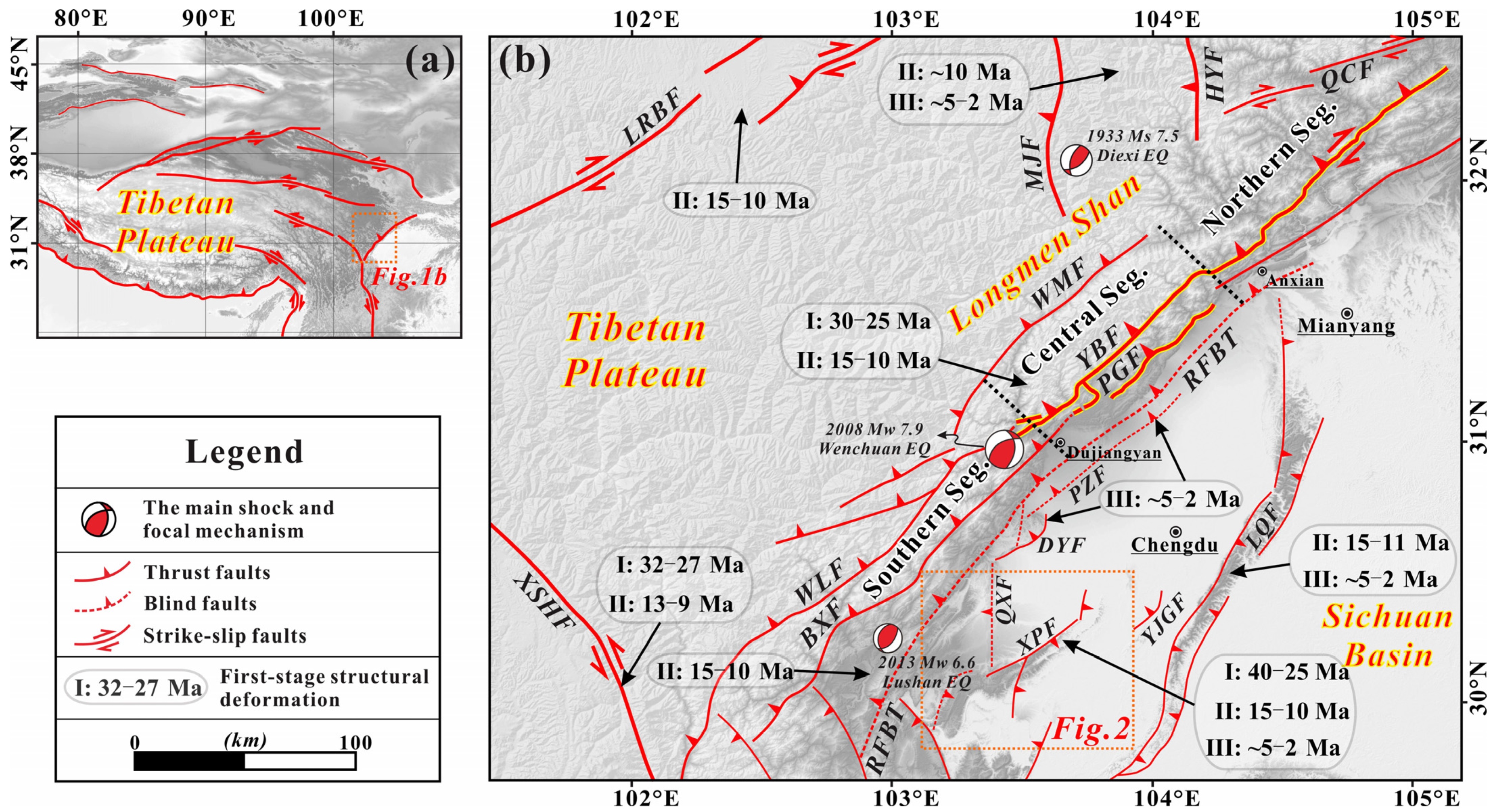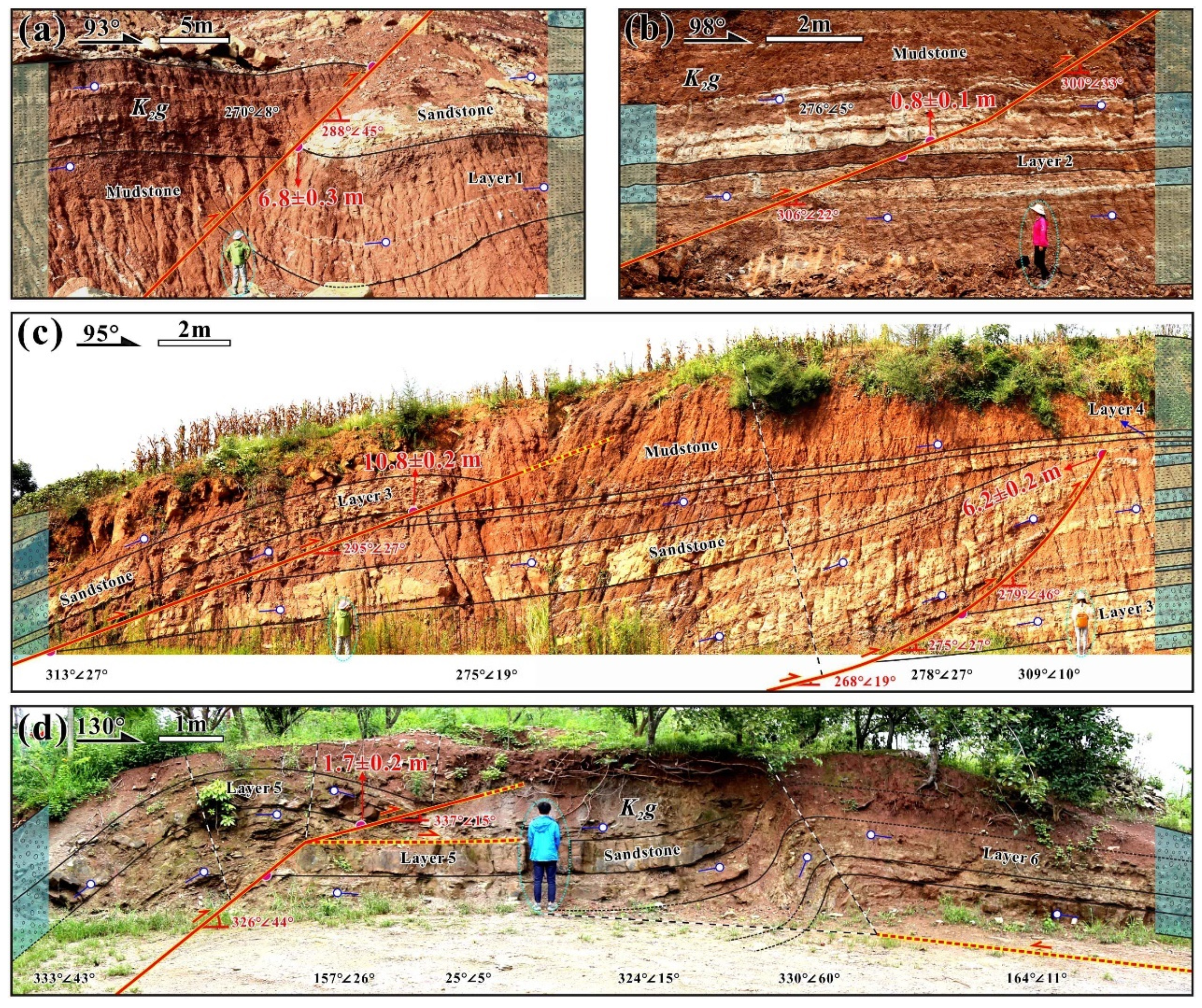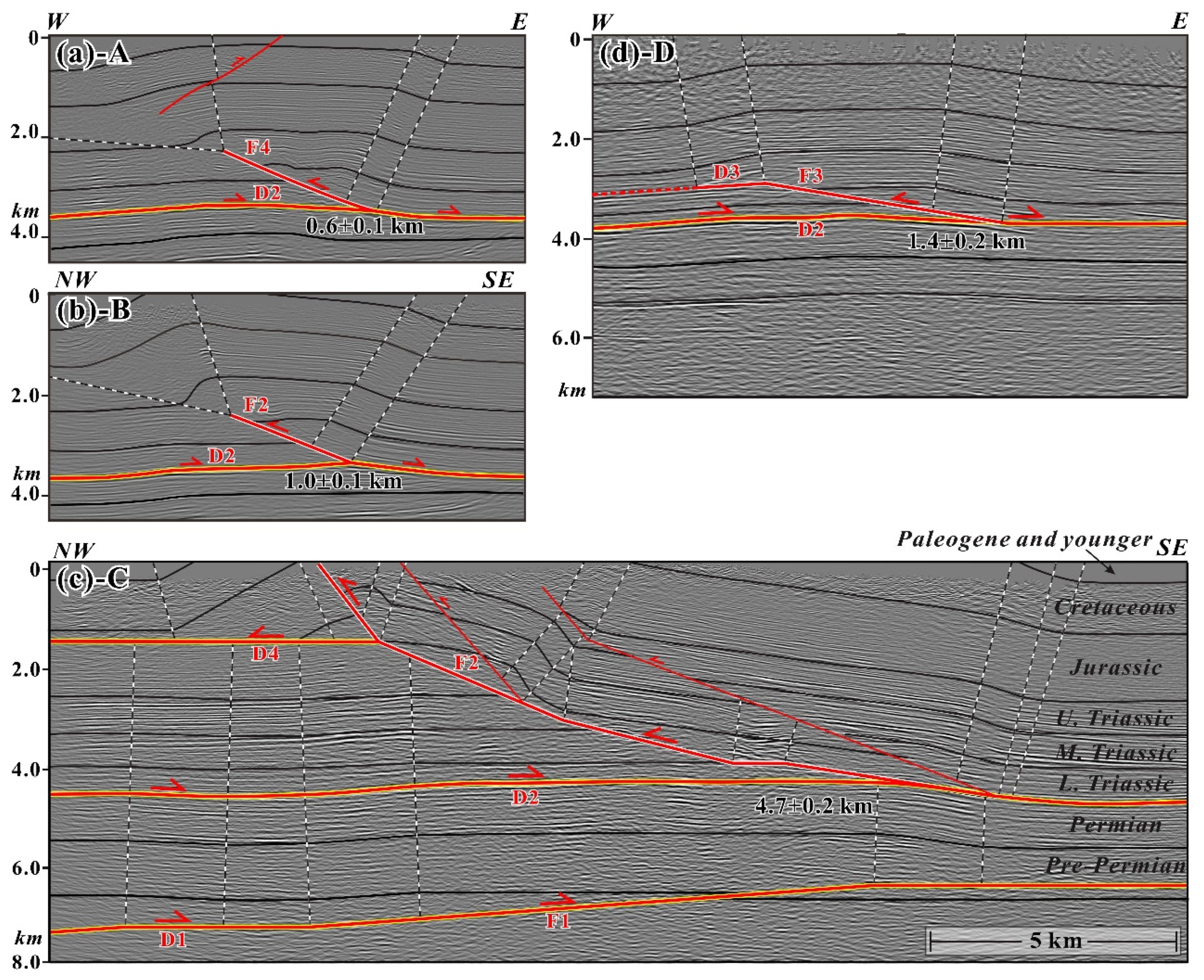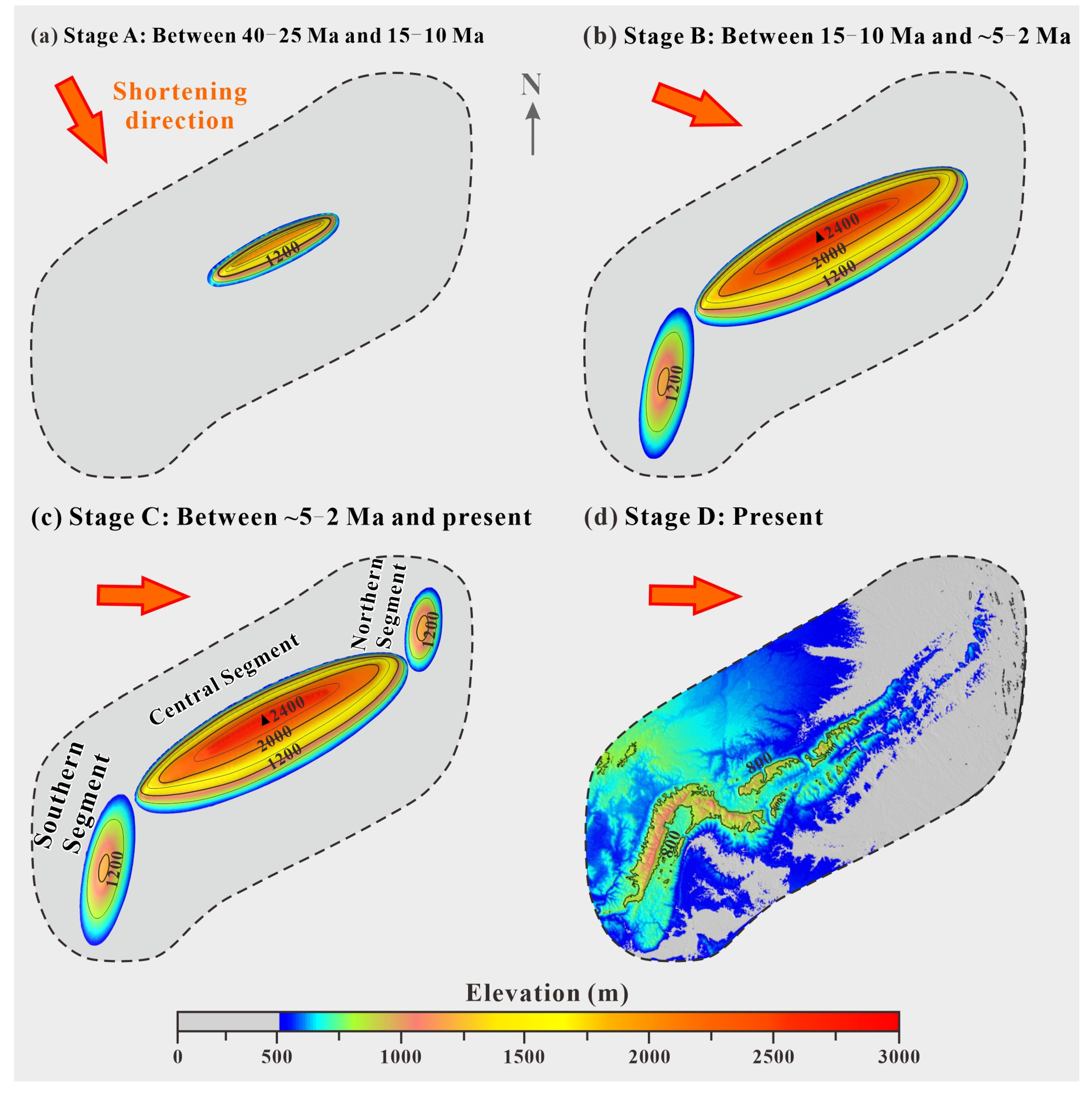Three-Dimensional Fault-Fold Growth Deciphered from Combined Seismic and Geological Data: A Case Study from the Xiongpo Anticline, Longmen Shan Piedmont
Abstract
:Highlights
- The Xiongpo anticline is characterized by a superimposed fault-fold belt in the central seg-ment, with a simple shallow fault-related fold in its two plunging edge zones.
- A three-stage growth of the Xiongpo anticline has been proposed on the basis of a 3D fault model.
- Three stress fields have been deduced for the Xiongpo anticline evolution.
Abstract
1. Introduction
2. Geological Setting
2.1. Cenozoic Crustal Deformation of the Eastern Tibet
2.2. Geomorphological and Geological Settings of the Xiongpo Structure
3. The Structural Architecture of the Xiongpo Structure
3.1. Central Segment
3.2. Southern Segment
3.3. Northern Segment
4. The 3D Fault Model of Xiongpo Structure
4.1. The 3D Structural Modeling Method
4.2. Model Results
5. Discussion
5.1. 3D Structural and Landscape Evolutions of the Xiongpo Structure
5.2. What Causes Triple-Stage Fault-Fold Growth of the Xiongpo Structure?
6. Conclusions
- (1)
- The Xiongpo anticline is characterized by a transition from a structural superposition of deep fault-bend fold and shallow structural wedge in the central segment to a simple shallow fault-bend fold, and then to a trishear fault propagation fold in two plunging zones.
- (2)
- The Xiongpo anticline experiences a three-stage evolution processes, beginning with a NE-striking fault that was active under the NW–SE compression between 40–25 Ma and 15–10 Ma, followed by lateral propagation of NE-striking fault and the initiation of ENE-striking fault till ~5–2 Ma, and finally ~N–S fault active under ~E–W compression until present.
- (3)
- The presented fault-fold growth history of the Xiongpo structure reveals two stress field changes in the eastern Tibet since Late Eocene, which may be related to the combination of the southeastward growth of the Tibetan Plateau along the Xianshuihe fault and northeastward escape of the Songpan–Ganzi block.
Author Contributions
Funding
Conflicts of Interest
References
- Davis, D.; Suppe, J.; Dahlen, F.A. Mechanics of fold-and-thrust belts and accretionary wedges. J. Geophys. Geol. 1983, 88, 1153–1172. [Google Scholar] [CrossRef]
- Dahlen, F.A. Noncohesive Critical Coulomb wedges: An exact solution. J. Geophys. Res. 1984, 89, 10125–10133. [Google Scholar] [CrossRef]
- Dahlen, F.A. Critical taper model of fold-and-thrust belts and accretionary wedges. Annu. Rev. Earth Planet. Sci. 1990, 18, 55–99. [Google Scholar] [CrossRef]
- Whipple, K.X. The influence of climate on the tectonic evolution of mountain belts. Nat. Geosci. 2009, 2, 97–104. [Google Scholar] [CrossRef]
- Wolf, S.G.; Huismans, R.S.; Braun, J.; Yuan, X.P. Topography of mountain belts controlled by rheology and surface processes. Nature 2022, 606, 516–521. [Google Scholar] [CrossRef]
- Di Paolo, L.; Aldega, L.; Corrado, C.; Mastalerz, M. Maximum burial and unloosing of Mt. Judica recess area in Sicily: Implication for the Apenninic–Maghrebian wedge dynamics. Tectonophysics 2012, 530–531, 193–207. [Google Scholar] [CrossRef]
- Di Paolo, L.; Olivetti, V.; Corrado, S.; Aldega, L.; Balestrieri, M.L.; Maniscalco, R. Detecting the stepwise propagation of the Eastern Sicily thrust belt (Italy): Insight from thermal and thermochronological constraints. Terra Nova 2014, 26, 363–371. [Google Scholar] [CrossRef]
- Balestra, M.; Corrado, S.; Aldega, L.; Rudkiewicz, J.L.; Gasparo Morticelli, M.; Sulli, A.; Sassi, W. 3D structural modeling and restoration of the Apennine-Maghrebian chain in Sicily: Application for non-cylindrical fold-and-thrust belts. Tectonophysics 2019, 761, 86–107. [Google Scholar] [CrossRef]
- Fletcher, R.C. Three-dimensional folding of an embedded viscous layer in pure shear. J. Struct. Geol. 1991, 13, 87–96. [Google Scholar] [CrossRef]
- Schmid, D.W.; Dabrowski, M.; Krotkiewski, M. Evolution of large amplitude 3D fold patterns: A FEM study. Phys. Earth Planet. Inter. 2008, 171, 400–408. [Google Scholar] [CrossRef]
- Yamato, P.; Kaus, B.J.P.; Mouthereau, F.; Castelltort, S. Dynamic constraints on the crustal-scale rheology of the Zagros fold belt, Iran. Geology 2011, 39, 815–818. [Google Scholar] [CrossRef]
- Grasemann, B.; Schmalholz, S.M. Lateral fold growth and fold linkage. Geology 2012, 40, 1039–1042. [Google Scholar] [CrossRef]
- Collignon, M.; Fernandez, N.; Kaus, B.J.P. Influence of surface processes and initial topography on lateral fold growth and fold linkage mode. Tectonics 2015, 34, 1622–1645. [Google Scholar] [CrossRef]
- Collignon, M.; Yamato, P.; Castelltort, S.; Kaus, B.J.P. Modeling of wind gap formation and development of sedimentary basins during fold growth: Application to the Zagros Fold Belt, Iran. Earth Surf. Process. Landforms 2016, 41, 1521–1535. [Google Scholar] [CrossRef] [Green Version]
- Cotton, J.; Koyi, H. Modelling of thrust fronts above ductile and frictional decollements; examples from The Salt Range and Potwar Plateau, Pakistan. Geol. Soc. Am. Bull. 2000, 112, 351–363. [Google Scholar] [CrossRef]
- McClay, K.; Whitehouse, P. Analogue modelling of thrust belts formed by oblique subduction. In Thrust Tectonics and Petroleum Systems; McClay, K., Ed.; American Association of Petroleum Geologist Memoir: Tulsa, OK, USA, 2004; p. 82. [Google Scholar]
- Keller, E.A.; Zepeda, R.L.; Rockwell, T.K.; Ku, T.L.; Dinklage, W.S. Active tectonics at Wheeler Ridge, southern San Joaquin Valley, California. Geol. Soc. Am. Bull. 1998, 110, 298–310. [Google Scholar] [CrossRef]
- Burbank, D.W.; McLean, J.K.; Bullen, M.; Abdrakhmatov, K.Y.; Miller, M.M. Partitioning of intermontane basins by thrust-related folding, Tien Shan, Kyrgyzstan. Basin Res. 1999, 11, 75–92. [Google Scholar] [CrossRef] [Green Version]
- Champel, B.; van der Beek, P.; Mugnier, J.L.; Leturmy, P. Growth and lateral propagation of fault-related folds in the Siwaliks of western Nepal: Rates, mechanisms, and geomorphic signature. J. Geophys. Res. 2002, 107, 2–18. [Google Scholar] [CrossRef]
- Ramsey, L.A.; Walker, R.T.; Jackson, J. Fold evolution and drainage development in the Zagros mountains of Fars province, SE Iran. Basin Res. 2008, 20, 23–48. [Google Scholar] [CrossRef]
- Bretis, B.; Bartl, N.; Grasemann, B. Lateral fold growth and linkage in the Zagros fold and thrust belt (Kurdistan, NE Iraq). Basin Res. 2011, 23, 615–630. [Google Scholar] [CrossRef]
- Shaw, J.H.; Connors, C.; Suppe, J. Seismic interpretation of contractional fault-related folds. Am. Assoc. Pet. Geol. 2005, 53, 1–58. [Google Scholar]
- Delcaillau, B.; Carozza, J.M.; Laville, E. Recent fold growth and drainage development: The Janauri and Chandigarh anticlines in the Siwalik foothills, northwest India. Geomorphology 2006, 76, 241–256. [Google Scholar] [CrossRef] [Green Version]
- Chen, J.; Heermance, R.; Burbank, D.W.; Scharer, K.M.; Miao, J.J.; Wang, C.S. Quantification of growth and lateral propagation of the Kashi anticline, southwest Chinese Tian Shan. J. Geophys. Res. 2007, 112. [Google Scholar] [CrossRef] [Green Version]
- Hubert-Ferrari, A.; Suppe, J.; Gonzalez-Mieres, R.; Wang, X. Mechanisms of active folding of the landscape (southern Tian Shan, China). J. Geophys. Res. 2007, 112. [Google Scholar] [CrossRef] [Green Version]
- Higgins, S.; Clarke, B.; Davies, R.J.; Cartwright, J. Internal geometry and growth history of a thrust-related anticline in a deep water fold belt. J. Struct. Geol. 2009, 31, 1597–1611. [Google Scholar] [CrossRef]
- Tang, P.C.; Rao, G.; Li, S.Q.; Yu, Y.L.; Pei, Y.W.; Wang, X.; Shen, Z.Y.; Chen, N.H.; Zhao, B. Lateral structural variations and drainage response along the Misikantage anticline in the western Kuqa fold-and-thrust belt, southern Tianshan, NW China. Tectonophysics 2017, 721, 196–210. [Google Scholar] [CrossRef]
- Jia, D.; Wei, G.Q.; Chen, Z.X.; Li, B.L.; Zeng, Q.; Yang, G. Longmen Shan fold-thrust belt and its relation to the western Basin in Central China: New insights from hydrocarbon exploration. AAPG Bull. 2006, 90, 1425–1447. [Google Scholar] [CrossRef]
- Zheng, W.J.; Wang, W.T.; Li, C.Y.; Wei, Z.Y.; Gao, X. The deformation of the Xiongpo anticline and the activity of Pujiang-Xinjin fault. Seism. Geol. 2008, 30, 957–967. [Google Scholar]
- Hubbard, J.; Shaw, J.H. Uplift of the Longmen Shan and Tibetan plateau, and the 2008 Wenchuan (M=7.9) earthquake. Nature 2009, 458, 194–197. [Google Scholar] [CrossRef]
- Li, Z.G.; Zhang, P.Z.; Zheng, W.J.; Jia, D.; Hubbard, J.; Almeida, R.; Sun, C.; Shi, X.H.; Li, T. Oblique thrusting and strain partitioning in the Longmen Shan fold-and-thrust belt, eastern Tibetan Plateau. J. Geophys. Res. Solid Earth 2018, 123, 4431–4453. [Google Scholar] [CrossRef]
- Li, Z.G.; Zheng, W.J.; Zhang, P.Z.; Almeida, R.; Jia, D.; Sun, C.; Wang, W.T.; Li, T. Evidence for three Cenozoic phases of upper crustal shortening of the Xiongpo structure in the Longmen Shan fold-and-thrust belt, China: Implications for the eastward growth of the eastern Tibetan Plateau. J. Asian Earth Sci. 2019, 179, 138–148. [Google Scholar] [CrossRef]
- Richardson, N.J.; Densmore, A.L.; Seward, D.; Fowler, A.; Wipf, M.; Ellis, M.A.; Li, Y.; Zhang, Y. Extraordinary denudation in the Sichuan Basin: Insights from low temperature thermochronology adjacent to the eastern margin of the Tibetan Plateau. J. Geophys. Res. 2008, 113, B04409. [Google Scholar] [CrossRef]
- Jia, D.; Li, Y.Q.; Yan, B.; Li, Z.G.; Wang, M.M.; Chen, C.X.; Zhang, Y. The Cenozoic thrusting sequence of the Longmen Shan fold-and-thrust belt, eastern margin of the Tibetan plateau: Insights from low-temperature thermochronology. J. Asian Earth Sci. 2020, 198, 104381. [Google Scholar] [CrossRef]
- Tapponnier, P.; Xu, Z.Q.; Roger, F.; Meyer, B.; Arnaud, N.; Wittlinger, G.; Yang, J.S. Oblique, Stepwise Rise and Growth of the Tibet Plateau. Science 2001, 294, 1671–1677. [Google Scholar] [CrossRef]
- Zhang, G.H.; Tian, Y.T.; Li, R.; Shen, X.M.; Zhang, Z.J.; Sun, X.L.; Chen, D.X. Progressive tectonic evolution from crustal shortening to mid-lower crustal expansion in the southeast Tibetan Plateau: A synthesis of structural and thermochronological insights. Earth-Sci. Rev. 2022, 226, 103951. [Google Scholar] [CrossRef]
- Kirby, E.; Reiners, P.W.; Krol, M.A.; Whipple, K.X.; Hodges, K.V.; Farley, K.A.; Tang, W.; Chen, Z.L. Late Cenozoic evolution of the eastern margin of the Tibetan Plateau: Inferences from 40Ar/39Ar and (U–Th)/He thermochronolgy. Tectonics 2002, 21, 1-1-1-20. [Google Scholar] [CrossRef] [Green Version]
- Clark, M.K.; House, M.A.; Royden, L.H.; Whipple, K.X.; Burchfiel, B.C.; Zhang, X.; Tang, W. Late Cenozoic uplift of southeastern Tibet. Geology 2005, 33, 525–528. [Google Scholar] [CrossRef] [Green Version]
- Godard, V.; Pik, R.; Lavé, J.; Cattin, R.; Tibari, B.; de Sigoyer, J.; Pubellier, M.; Zhu, J. Late Cenozoic evolution of the central Longmen Shan, eastern Tibet: Insight from (U-Th)/He thermochronometry. Tectonics 2009, 28. [Google Scholar] [CrossRef] [Green Version]
- Wang, E.; Kirby, E.; Furlong, K.P.; van Soest, M.; Xu, G.; Shi, X.; Kamp, P.J.J.; Hodges, K.V. Two-phase growth of high topography in eastern Tibet during the Cenozoic. Nat. Geosci. 2012, 5, 640–645. [Google Scholar] [CrossRef]
- Tian, Y.; Kohn, B.P.; Gleadow, A.J.W.; Hu, S. Constructing the Longmen Shan eastern Tibetan Plateau margin: Insights from lowtemperature thermochronology. Tectonics 2013, 32, 576–592. [Google Scholar] [CrossRef]
- Roger, F.; Calassou, S.; Lancelot, J.; Malavieille, J.; Mattauer, M.; Zhiqin, X.; Ziwen, H.; Liwei, H. Miocene emplacement and deformation of the Konga Shan granite (Xianshui He fault zone, west Sichuan, China): Geodynamic implications. Earth Planet. Sci. Lett. 1995, 130, 201–216. [Google Scholar] [CrossRef]
- Li, H.; Zhang, Y. Zircon U–Pb geochronology of the Konggar granitoid and migmatite: Constraints on the Oligo-Miocene tectono-thermal evolution of the Xianshuihe fault zone, East Tibet. Tectonophysics 2013, 606, 127–139. [Google Scholar] [CrossRef]
- Zhang, Y.Z.; Replumaz, A.; Leloup, P.H.; Wang, G.C.; Bernet, M.; van der Beek, P.; Paquette, J.L.; Chevalier, M.L. Cooling history of the Gongga batholith: Implications for the Xianshuihe Fault and Miocene kinematics of SE Tibet. Earth Planet. Sci. Lett. 2017, 465, 1–15. [Google Scholar] [CrossRef]
- Tian, Y.T.; Li, R.; Tang, Y.; Xu, X.; Wang, Y.J.; Zhang, P.Z. Thermochronological constraints on the late Cenozoic morphotectonic evolution of the Min Shan, the eastern margin of the Tibetan Plateau. Tectonics 2018, 37, 1733–1749. [Google Scholar] [CrossRef]
- Ansberque, C.; Godard, V.; Olivetti, V.; Bellier, O.; de Sigoyer, J.; Bernet, M.; Stübner, K.; Tan, X.B.; Xu, X.W.; Ehlers, T.A. Differential exhumation across the Longriba fault system: Implications for the eastern Tibetan Plateau. Tectonics 2018, 37, 663–679. [Google Scholar] [CrossRef]
- Li, Z.G.; Liu-Zeng, J.; Jia, D.; Sun, C.; Wang, W.; Yuan, Z.D.; Liu, B.J. Quaternary activity of the range front thrust system in the Longmen Shan piedmont, China, revealed by seismic imaging and growth strata. Tectonics 2016, 35, 2807–2827. [Google Scholar] [CrossRef] [Green Version]
- Suppe, J. Geometry and kinematics of fault-bend folding. Am. J. Sci. 1983, 283, 684–721. [Google Scholar] [CrossRef]
- Erslev, E.A. Trishear fault-propagation folding. Geology 1991, 19, 617–620. [Google Scholar] [CrossRef]
- Mallet, J.L. Discrete smooth interpolation in geometric modeling. Comput. Aided Des. 1992, 24, 178–191. [Google Scholar] [CrossRef]
- Fischer, M.P.; Wilkerson, M.S. Predicting the orientation of joints from fold shape: Results of pseudo-three-dimensional modeling and curvature analysis. Geology 2000, 28, 15–18. [Google Scholar] [CrossRef]
- Li, Z.G.; Jia, D.; Chen, W.; Yin, H.W.; Shen, L.; Sun, C.; Zhang, Y.; Li, Y.Q.; Li, S.Q.; Zhou, X.J.; et al. Late Cenozoic east-west crustal shortening in the southern Longmen Shan, eastern Tibet: Implications for regional stress field changes. Tectonophysics 2014, 623, 169–186. [Google Scholar] [CrossRef]
- Hao, M.; Wang, Q.L.; Zhang, P.Z.; Li, Z.J.; Li, Y.H.; Zhuang, W.Q. “Frame wobbling” causing crustal deformation around the Ordos block. Geophys. Res. Lett. 2021, 48, e2020GL091008. [Google Scholar] [CrossRef]
- Tian, Y.T.; Kohn, B.P.; Qiu, N.S.; Yuan, Y.S.; Hu, S.B.; Gleadow, A.J.W.; Zhang, P.Z. Eocene to Miocene out-of-sequence deformation in the eastern Tibetan Plateau: Insights from shortening structures in the Sichuan Basin. J. Geophys. Res. Solid Earth 2018, 123, 1840–1855. [Google Scholar] [CrossRef]
- Li, J.; Li, H.; Yang, C.; Wu, Y.J.; Gao, Z.; Jiang, S.L. Geological characteristics and controlling factors of deep shale gas enrichment of the Wufeng-Longmaxi Formation in the southern Sichuan Basin, China. Lithosphere 2022, 2022, 4737801. [Google Scholar] [CrossRef]
- Wang, E.; Meng, K.; Su, Z.; Meng, Q.Q.; Chu, J.J.; Chen, Z.L.; Wang, G.; Shi, X.H.; Liang, X.Q. Block rotation: Tectonic response of the Sichuan basin to the southeastward growth of the Tibetan Plateau along the Xianshuihe-Xiaojiang fault. Tectonics 2014, 33, 686–718. [Google Scholar] [CrossRef]
- Tong, Y.B.; Sun, Y.J.; Wu, Z.H.; Mao, C.P.; Pei, J.L.; Yang, Z.Y.; Pu, Z.W.; Zhao, Y.; Xu, H. Passive crustal clockwise rotational deformation of the Sichuan Basin since the Miocene and its relationship with the tectonic evolution of the fault systems on the eastern edge of the Tibetan Plateau. GSA Bull. 2019, 131, 175–190. [Google Scholar] [CrossRef]








Publisher’s Note: MDPI stays neutral with regard to jurisdictional claims in published maps and institutional affiliations. |
© 2022 by the authors. Licensee MDPI, Basel, Switzerland. This article is an open access article distributed under the terms and conditions of the Creative Commons Attribution (CC BY) license (https://creativecommons.org/licenses/by/4.0/).
Share and Cite
Li, X.; Zheng, X.; Dai, X.; Almeida, R.; Sun, C. Three-Dimensional Fault-Fold Growth Deciphered from Combined Seismic and Geological Data: A Case Study from the Xiongpo Anticline, Longmen Shan Piedmont. Minerals 2022, 12, 1405. https://doi.org/10.3390/min12111405
Li X, Zheng X, Dai X, Almeida R, Sun C. Three-Dimensional Fault-Fold Growth Deciphered from Combined Seismic and Geological Data: A Case Study from the Xiongpo Anticline, Longmen Shan Piedmont. Minerals. 2022; 12(11):1405. https://doi.org/10.3390/min12111405
Chicago/Turabian StyleLi, Xianyi, Xinru Zheng, Xiangming Dai, Rafael Almeida, and Chuang Sun. 2022. "Three-Dimensional Fault-Fold Growth Deciphered from Combined Seismic and Geological Data: A Case Study from the Xiongpo Anticline, Longmen Shan Piedmont" Minerals 12, no. 11: 1405. https://doi.org/10.3390/min12111405



